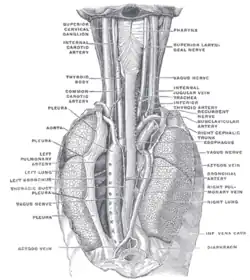Bronchial artery
| Bronchial artery | |
|---|---|
 Bronchial artery labeled at center right | |
| Details | |
| Source | Thoracic aorta |
| Vein | Bronchial veins |
| Supplies | Lungs |
| Identifiers | |
| Latin | Arteriae bronchiales, rami bronchiales partis thoracicae aortae |
| MeSH | D001981 |
| TA98 | A12.2.11.002 |
| TA2 | 4579 |
| FMA | 68109 71536, 68109 |
| Anatomical terminology | |
In human anatomy, the bronchial arteries supply the lungs with nutrition and oxygenated blood. Although there is much variation, there are usually two bronchial arteries that run to the left lung, and one to the right lung and are a vital part of the respiratory system.
Structure
There are typically two left and one right bronchial arteries.[1]
The left bronchial arteries (superior and inferior) usually arise directly from the thoracic aorta.[2]
The single right bronchial artery usually arises from one of the following:
- 1) the thoracic aorta at a common trunk with the right 3rd posterior intercostal artery
- 2) the superior bronchial artery on the left side
- 3) any number of the right intercostal arteries mostly the third right posterior.
Function
The bronchial arteries supply blood to the bronchi and connective tissue of the lungs. They travel with and branch with the bronchi, ending about at the level of the respiratory bronchioles. They anastomose with the branches of the pulmonary arteries, and together, they supply the visceral pleura of the lung in the process.
Note that much of the oxygenated blood supplied by the bronchial arteries is returned via the pulmonary veins rather than the bronchial veins. As a consequence, blood returning to the left heart is slightly less oxygenated than blood found at the level of the pulmonary capillary beds.
Each bronchial artery also has a branch that supplies the esophagus.
Comparison with pulmonary arteries
It is easy to confuse the bronchial arteries with the pulmonary arteries, because they both supply the lungs with blood, but there are important differences:
| artery | function | circulation | diameter |
| pulmonary arteries | supplies deoxygenated blood pumped from the right ventricle | pulmonary circulation | relatively large |
| bronchial arteries | supplies oxygenated blood pumped from the left ventricle | systemic circulation | relatively small |
Clinical significance
Bronchial artery is considered dilated when its diameter is more than 2 mm. Several causes of bronchial artery dilatations are: congenital heart or lung diseases, obstructions of pulmonary artery, and lung inflammation.[1]
The bronchial arteries are typically enlarged and tortuous in chronic pulmonary thromboembolic hypertension.[3]
With modern surgical techniques, bronchial anastomoses heal well without bronchial artery reconnection. Largely for this reason, bronchial artery circulation is usually sacrificed during lung transplants, instead relying on the persistence of a microcirculation (presumably arising from the deoxygenated pulmonary circulation) to provide perfusion to the airways.[4]
Aneurysms of the bronchial artery may mimic aortic aneurysms.[5] Bronchial artery embolisation (BAE) is catheter insertion into a bronchial artery to treat hemopytsis (coughing blood).[6][7]
The bronchial arteries and their supply of nutrients to the lungs are also attributed to the observation that an occluded (either ligated or by an embolus) pulmonal artery very rarely results in lung infarction.[8] The bronchial arteries can maintain a supply of oxygenated blood to lung tissue.
See also
References
- 1 2 Marini TJ, He K, Hobbs SK, Kaproth-Joslin K (December 2018). "Pictorial review of the pulmonary vasculature: from arteries to veins". Insights Into Imaging. 9 (6): 971–987. doi:10.1007/s13244-018-0659-5. PMC 6269336. PMID 30382495.
- ↑ Leslie KO, Wick MR (January 2018). "Lung anatomy.". In Leslie KO, Wick MR (eds.). Practical Pulmonary Pathology: A Diagnostic Approach (Third ed.). Elsevier. pp. 1–14. doi:10.1016/b978-0-323-44284-8.00001-6. ISBN 978-0-323-44284-8.
- ↑ Kauczor HU, Schwickert HC, Mayer E, Schweden F, Schild HH, Thelen M (1994). "Spiral CT of bronchial arteries in chronic thromboembolism". Journal of Computer Assisted Tomography. 18 (6): 855–861. doi:10.1097/00004728-199411000-00002. PMID 7962789.
- ↑ Nowak K, Kamler M, Bock M, Motsch J, Hagl S, Jakob H, Gebhard MM (January 2002). "Bronchial Artery Revascularization affects Graft Recovery after Lung Transplantation". American Journal of Respiratory and Critical Care Medicine (AJRCCM). 165 (2): 216–20. doi:10.1164/ajrccm.165.2.2012101. PMID 11790658.
- ↑ Vernhet H, Bousquet C, Jean B, Lesnik A, Durand G, Giron J, Senac JP (1999). "Bronchial aneurysms mimicking aortic aneurysms: endovascular treatment in two patients". Cardiovascular and Interventional Radiology. 22 (3): 254–257. doi:10.1007/s002709900378. PMID 10382061.
- ↑ James WE (2019-01-01). "Chapter 23 - Nonpharmacological Therapy for Pulmonary Sarcoidosis". In Baughman RP, Valeyre D (eds.). Sarcoidosis. Philadelphia: Elsevier. pp. 277–284. doi:10.1016/b978-0-323-54429-0.00023-9. ISBN 978-0-323-54429-0.
- ↑ Garwood S, Strange C, Sahn SA (2008-01-01). "Chapter 47 - Massive Hemoptysis". In Parrillo JE, Dellinger RP (eds.). Critical Care Medicine (Third ed.). Philadelphia: Mosby. pp. 929–948. doi:10.1016/b978-032304841-5.50049-2. ISBN 978-0-323-04841-5.
- ↑ Fishman AP (September 1961). "The clinical significance of the pulmonary collateral circulation". Circulation. American Heart Association. 24 (3): 677–690. doi:10.1161/01.CIR.24.3.677. eISSN 1524-4539. PMID 13700013.
External links
- Anatomy figure: 21:06-06 at Human Anatomy Online, SUNY Downstate Medical Center - "Branches of the ascending aorta, arch of the aorta, and the descending aorta."
- Histology image: 13903loa – Histology Learning System at Boston University
- Bronchial arteries - anatquest.nlm.nih.gov.
Vital volume is 4600ml
Residual volume is 1200ml